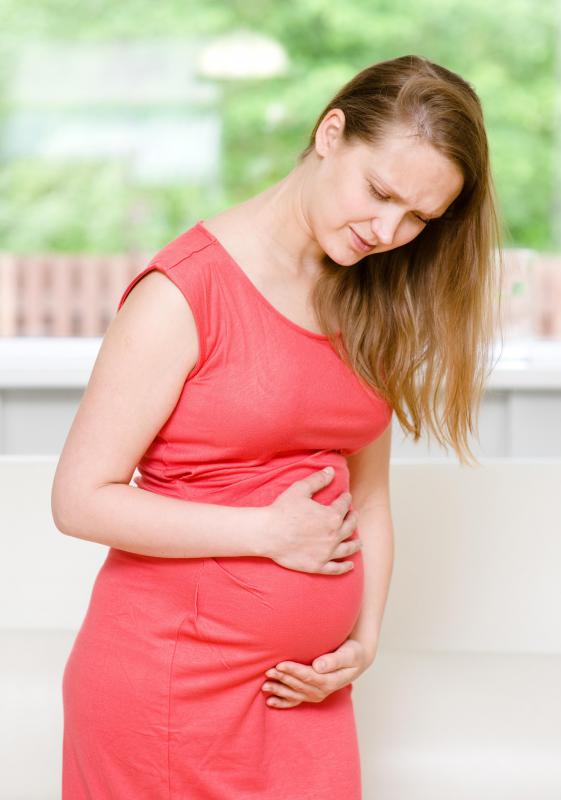At WiseGEEK, we're committed to delivering accurate, trustworthy information. Our expert-authored content is rigorously fact-checked and sourced from credible authorities. Discover how we uphold the highest standards in providing you with reliable knowledge.
What is a Uterine Polyp?
A uterine polyp is also known as an endometrial polyp. These polyps are growths that occur in the lining, or endometrium, of the uterus. They can be roughly as small as a sesame seed or as large as a golf ball. A single uterine polyp could develop, or multiple polyps could occur together. In most cases, polyps remain in the uterus, but it is possible for them to move into the vagina.
Some women who have a uterine polyp will experience no symptoms or signs of the growth. For women who do develop symptoms, they could include particularly heavy or irregular menstrual periods. Other possible symptoms include bleeding or spotting between periods, post-menopausal bleeding or infertility.

There is no clear cause for this condition. They occur when there is excessive cell-growth in the uterine lining. Hormones could have an effect on the development of the polyps, because the way they respond to estrogen is the same way the endometrium responds. Both the endometrium and uterine polyps grow larger in the presence of estrogen.
Certain women are at a greater risk of developing polyps in the uterus. Polyps are most likely to occur in women who are in their 40s or 50s. Other risk factors include the presence of cervical polyps, high blood pressure and obesity. The breast cancer drug tamoxifen also could increase a woman's chance of developing uterine polyps.

A physician can use several tests to diagnose this condition. Transvaginal ultrasound could be used to create an image of the inside of the uterus. A physician can also perform a hysteroscopy to closely examine the uterine interior and possibly remove polyps if they are present. Another procedure is called dilation and curettage, during which a doctor uses an instrument to scrape the lining of the uterus. This procedure can be used to collect tissues for biopsy or to remove polyps.

If a woman has been undergoing in-vitro fertilization, the presence of polyps can increase her risk of miscarriage. For other women who have had difficulty conceiving, removal of polyps could help increase their chances of conception. In most cases, the polyps are benign, but a polyp could indicate precancerous conditions in the uterus.
For some women, treatment for a polyp in the uterus might be unnecessary. In some cases, a polyp could go away on its own. For other women looking for a short-term treatment, medication might help minimize the polyp and alleviate symptoms for a period of time. A woman could also choose to undergo a surgical procedure to remove the polyps, including the hysteroscopy or dilation and curettage. In severe cases where cancer is likely, a doctor might recommend a hysterectomy to remove the uterus.
AS FEATURED ON:
AS FEATURED ON:


















Discussion Comments
I have been trying to conceive for 18 months. My doctor found a 1cm polyp in my uterus. It causes the uterine wall to have a ripple in it, so the egg can't implant into the wall and grow. My polyp was at the entrance to my fallopian tubes, so nothing was getting in!
I've had a hysteroscopy and polypectomy (i.e., removal of polyp). Polyps can cause miscarriage, so my doctor said to remove it now to reduce potential probes later. Mine and my husband's other fertility tests (sperm, ovulation, hormones, egg production etc) were absolutely normal. Hope this helps!
I'm not surprised you are confused! It's good, however that there is no polyp, obviously making it easier for you to conceive! Be patient about conceiving. I know that if you try too hard, sometimes it doesn't happen and when you least expect it to, it happens! How old are you?
I was diagnosed with a 1.3 cm uterine polyp via a scan in april 2010, which after investigation and signs that I'm ovulating, my gyno said that it was the only explanation for my infertility and yesterday i went in for a hysteroscopy for its removal and after my procedure my surgeon told me that there was no sign of a polyp but he did take a scraping of my uterine wall for testing.
This has left me very confused in trying to understand my infertility problem and what is going on. Can anyone please help me understand what has happened and where we go from here? Me and my husband have been trying for four years now and don't know where to go from here.
My first progesterone test was 24.6 and my second one was 84.3 so i know I'm ovulating good and my husband has been tested and everything is good with his semen. Help.
Post your comments